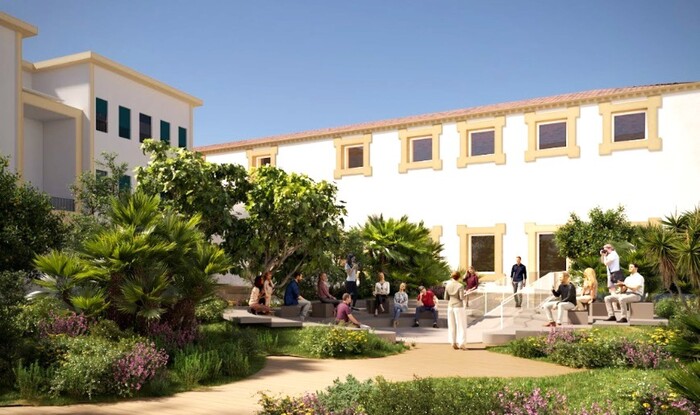Bad fame precedes concrete.
Its composition, mainly cement —each cubic meter of concrete requires approximately 300 kilos of this material— consumes a lot of energy during its production phase and emits large amounts of CO2 into the atmosphere —cement is responsible for 8% of global emissions —.
The non-profit association Green Building Council Spain (GBCe) has hit the nail on the head.
Recently, he alluded to how buildings impact biodiversity and gave the most popular construction material in the world as an example.
“The sector produces, for example, 2,200 tons of concrete every two seconds in the world, more than 4,000 million tons of this material per year and 9 tons of concrete per person in the same period, turning natural spaces into industrial estates or in blocks of flats”, according to Borja Izaola, an expert in the technical area of GBCe.
The problem is that there is no viable alternative to concrete.
In the short term, there is no other construction material that can replace it in terms of volume.
For this reason, experts consider that the most feasible path is to improve its sustainability.
The construction sector is already trying to reduce its water footprint, for example by recycling water used in cleaning concrete mixer trucks or in precast concrete plants.
Residues or waste from other industrial, agricultural or domestic processes that are not recyclable or reusable are also being used as raw material or fuel to manufacture cement, according to Cemex, a materials company for the construction industry.
The development sector is also taking the first steps in this direction.
Aedas Homes and Holcim Spain have announced an agreement to build at least three developments of 200 homes using concrete with a low carbon footprint.
A solution that will foreseeably allow a reduction in CO2 emissions of between 30% and 70% compared to traditional concrete and mortar.
"The product's life cycle analysis (LCA) methodology is used, which allows us to know the main environmental impacts derived from its production and use, also providing total transparency about the process," maintains Manuel Barrero, director of the concrete activity of Holcim Spain.
César Bartolomé, secretary of the Spanish Concrete Technology Platform, says that "there is nothing more sustainable than an eternal building and, until we achieve it, concrete is the longest-lived and safest construction material that exists."
Despite being a material responsible for a high percentage of global CO2 emissions worldwide, Bartolomé defends it: “Cement tends to be confused with concrete, and this can cause confusion.
Concrete is the mixture of cement, aggregates, additives and water, and it is the material that, in general, is used in works.
One of its major components, the aggregate, has a very low environmental impact, which makes concrete a material with a medium-low carbon footprint”.
The reason why this expert believes that concrete is singled out as one of the main contributors to climate change is not precisely its carbon footprint per product unit, but because it is the most widely used material globally, so its impact is also older.
“The question we must ask ourselves is whether we can use less concrete in a building.
The answer is yes, but with caution and with certain limits, because concrete provides us with the structural safety, fire resistance or energy efficiency that the building needs”, insists Bartolomé.
“The question we must ask ourselves is whether we can use less concrete in a building.
The answer is yes, but with caution and with certain limits, because concrete provides us with the structural safety, fire resistance or energy efficiency that the building needs”, insists Bartolomé.
“The question we must ask ourselves is whether we can use less concrete in a building.
The answer is yes, but with caution and with certain limits, because concrete provides us with the structural safety, fire resistance or energy efficiency that the building needs”, insists Bartolomé.
Of Transition
The European Commission has included cement and its by-products in the EU green taxonomy regulation —which establishes the criteria for determining whether an economic activity is considered environmentally sustainable— as a climate transition technology.
"The Commission has declared that there is no technologically and economically viable low-carbon alternative that can replace cement and concrete by 2050," the date on which the EU commits to achieving carbon neutrality, points out the Secretary of the concrete platform.
Construction processes and alternative construction methods such as industrialization have also evolved, increasing the sustainability of the construction process.
According to the company Sika, the percentage of prefabricated construction with concrete is 38%, while steel is around 41% and wood 21%.
Regarding the circular economy, concrete can be completely recycled.
“When it is properly recovered, with sufficient purity, its circularity can be complete.
The most recommended processes before that, however, would be repair, reuse and remanufacturing to extend the useful life of the concrete with fewer environmental and economic consequences”, explains Cristina Valverde, head of R&D for the concrete area at Sika.
This company has developed a strategic plan to support the construction industry throughout the entire concrete value chain: helping to optimize the use of energy in the cement production phase, increasing the use of calcined clays, minimizing the water and optimizing the cement or reducing the curing time of the concrete.
The Swiss company believes that the use of its systems will make it possible to save 65 million tons of CO2 emissions and 6,000 million liters of water annually.
Follow all the information on
Economy
and
Business
on
and
, or in our
weekly newsletter
Subscribe to continue reading
Read without limits
Keep reading
I'm already a subscriber

/cloudfront-eu-central-1.images.arcpublishing.com/prisa/DO3KLVHC3FAPBCURI3PWIHVSTI.jpg)












